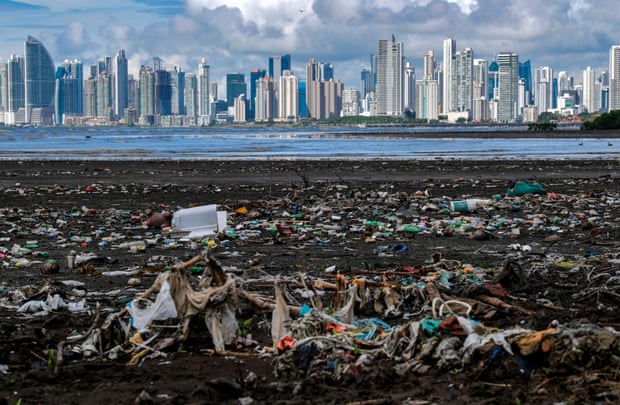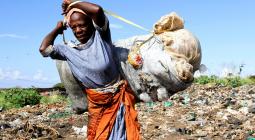The plastic polluters won 2019 – and we're running out of time to stop them

Further steps have been taken to clean up beaches and seas in 2019 – but much more needs to be done
The beach at Muncar on the island of Java was revolting. The 400-yard wide, mile-long stretch of sand was feet deep in foul-smelling sauce sachets, shopping bags, nappies, bottles and bags, plastic clothes and detergent bottles. Bulldozers had cleared away and buried some of the huge mat of plastic and sand two years ago, but every tide since then had washed up more rubbish from the ocean, and every day tonnes more plastic was washed down the rivers from upstream towns and villages. Now it was fouling the fishing boats’ propellers.
“We fear for the future,” one elderly woman said. She remembered Muncar only a decade ago as one of the most picturesque towns in Indonesia and a tourist hotspot. “If it carries on like this we will be buried in plastic. We have no choice but to throw plastic into the rivers. Now we are angry. Something must be done,” she said.
That was January 2019. One year later, the beach heaves with plastic but the local government, working with well-funded international advisers, a recycling company and an army of volunteer collectors have worked to stem the tide of plastic reaching its beaches. It will cost millions of dollars and take years but Muncar may soon have its sand back.
But this small Indonesian town is the exception. 2019 was, for most of the world, the year the petrochemical industry and giant food, drink and beauty companies locked the world even further into fossil fuels, creating mountains of plastic for communities and future generations to deal with and making it almost too late to keep global temperatures in check.
Ultra-cheap shale gas from the decade-long US fracking boom continued to fuel a surge of billion-dollar investments in new cracking plants that separate ethane from gas to produce ethylene, the building block of most plastic. Since 2010 the petrochemical industry has invested about $200bn, and with $100bn more planned to be spent, plastic production is expected to grow 40% by 2030.

The implications for countries struggling to cope with climate change and thousands of communities fighting tides of plastic are only now being understood. From having little impact on the climate just 20 years ago, the production and disposal of plastic now uses nearly 14% of all the world’s oil and gas. Plastic production is expected to grow to 20% by 2050 by which time the industry’s climate emissions could rise to 2.75bn tonnes a year and plastic could be driving half of all oil demand growth.
Plastic, says the International Energy Agency, could take up to 15% of the remaining annual carbon budget and make the fast-growing industry the equivalent of the world’s fifth largest climate heating country, emitting more than Germany or the UK, twice as much as all African countries and nearly as much as shipping and aviation combined.
Even as anger mounted in 2019 against rich countries’ reluctance to act on climate change, it became clear that plastic was big oil’s great hope for expansion, and one of the world’s leading drivers of climate change. Shell’s giant $6bn ethane-cracking plant being built near Pittsburgh, will produce 1.6m tons of plastic a year but is just one of dozens of similar size plants planned for the US, India, China and the Middle East.
Despite UN hand-wringing and corporate pledges, demand for plastics grew a further 3.5% in 2019 and up to 16% in much of Asia. Latest figures suggest 359 m tonnes were produced in 2018. Nearly one-third went to single-use packaging and less than 10% was recycled. The rest went to landfills, was burned in incinerators adding to emissions and increasing air pollution, or was left uncollected, with approximately 8m tons making its way to the sea via rivers.
But 2019 was also the year the worldwide revolt against plastic pollution translated into political and corporate action; when going plastic-free in Europe became trendy and giant food, drink and health companies were shamed. It was the year governments pledged new laws and when hundreds of potential solutions and initiatives were initiated.
Great steps were taken by the public to clean up beaches and seas but in Britain the size of the task was underlined in November when a sperm whale was found on a Scottish beach. An examination of its stomach revealed a 100kg ball of plastic rope, fishing nets, cups, shopping bags, gloves, packing straps, tubing, sachets, bottles and all the waste of the global consumer society. Such beachings were common in 2019, with plastic-filled whales and cetaceans washed up in Wales, the Philippines, Indonesia, Italy and the US.
Rattled by public disgust at the sight of choked animals and soiled coastlines, the packaging industry was forced to respond. Food and drink firms including Unilever, Mars, Danone, Pepsico and Coca-Cola pledged to reduce the amount of virgin plastic they used by 2025 and to increase the amount of recycled plastic. The global commitment on plastic, introduced in late 2018 to get corporations to pledge to use less and recycle more, grew to more than 400 of the world’s biggest companies. Together they are responsible for more than 20% of all the plastic packaging produced.
The UK supermarkets Tesco, Sainsbury’s, Asda, Morrisons and Waitrose raced to ditch hard-to-recycle “black” plastic from their ranges and to accelerate the amount of recycled material they use. Asda stated that nearly one-third of its plastic packaging would come from recycled sources by the end of 2020 and all should be recyclable by 2025. Waitrose said it had removed 90% of the 2,291 tonnes of black plastic. Some initiatives were eye-catching: Tesco pledged to remove 1bn pieces of plastic from products for sale in UK stores by the end of 2020.
Sir David Attenborough detected a cultural change, telling the Glastonbury crowds that the world was changing its habits on plastic. But he may have been wrong. Greenpeace and the Environment Investigations Agency showed that more plastic than ever was put on shop shelves in 2019 and only Waitrose, Tesco and Sainsbury’s of the 10 biggest chains marginally reduced the amounts they used. Plastic water bottle sales, indeed, soared.
Academic research, too, confirmed that pollution was worse than ever in 2019 and that the fishing industry was considerably responsible. The Dutch Ocean Cleanup project, working in the Great Pacific garbage patch, found more than half came from discarded plastic nets and rope, fish aggregating devices [FADs], buoys, long lines, crates and floats. French researchers showed how plastic litter at the bottom of the Mediterranean had tripled since 1990 and the Ellen MacArthur Foundation estimated that there would be more plastic than fish in the oceans by 2050 if business was allowed to continue as normal.

Wherever researchers looked, they were horrified. One study found an estimated 1.8m pieces of plastic, old tyres and fishing gear on the sea floor of the Bay of Fundy between Nova Scotia and New Brunswick in Canada; the WWF calculated that 570,000 tonnes of plastic went into the Mediterranean each year – the equivalent of 33,800 plastic bottles every minute and plastic was found widely in the food chain and in human bodies.
Under pressure from governments but unwilling to produce less, the industry turned in 2019 to bioplastics, which convert the sugar present in plants and crop residues into plastic. Big manufacturers such as BASF, Dow, Huhtamaki, Plantic, Mondi, and Amcor ramped up research into plastic from corn, wheat, potatoes, soyabean and cotton. The market is still small but is expected to grow 20% annually into a $70bn a year industry by 2024.
But critics said bioplastics were not the answer. Not only can they take up land needed for food production, but most bioplastics need high temperature industrial composting facilities to break them down. With few local authorities able to handle them, the result is most must go to landfills where they are likely to release methane, a greenhouse gas 23 times more potent than carbon dioxide.
Industry attempts to appear green mostly ended in confusion. Products were increasingly classed as compostable, biodegradable, recyclable, reusable or bio-based. But most of these terms meant little. Biodegradable plastic was found to be intact after years at sea; not all compostable materials, it was found, could be composted at home; and recyclable depended on the local waste stream; with few standards and no timescale attached to bioplastics, many were described as false solutions.
Faced with heavily polluted coastlines, a hostile media and angry tourists, the EU launched its plastics strategy in 2019 . This aims to ensure all plastic packaging is reusable or recyclable by 2030. It also calls for 90% of all plastic bottles to be recycled by 2025. The new UK government has pledged to ban the export of plastic waste to poor countries, and to introduce a tax on plastic packaging with less than 30% of recycled content from 2022. It also said it would stop by April 2020 the use of 4.7bn plastic straws, the 316m plastic stirrers and the 1.8bn plastic cotton buds used each year.

Asian countries, faced with massively polluted coastlines and a swiftly growing plastics market, promised to act.
India and Peru planned to eliminate all single-use plastic by 2022 and the Maldives said it would phase out all its non-biodegradable plastic. By the end of 2019, more than 120 countries had banned plastic bags and 60 more countries said they would impose taxes. Many US states banned or said they were planning to phase out plastic bags.
The industry fought back. Companies may have promised publicly to stop using certain types of plastic, but their trade bodies lobbied strongly in 2019 against new laws and argued to be allowed to continue to produce more. Industry and supermarket trade groups lobbied against proposed deposit return schemes, bans and new recycling targets. The US industry responded with threatening lawsuits against local authorities and cities who tried to introduce bag bans.
Instead of waiting for governments and industry, coalitions of global and local NGOs, international banks, conservation groups and some plastic producers volunteered to clean up rivers and beaches, and help governments collect and recycle waste. The UK-based Common Seas NGO worked with islands and resorts in the Maldives and Greece, and with city authorities in Indonesia to prevent plastic getting to the ocean. Volunteers cleared millions of pieces of plastic from beaches in the Mediterranean, Middle East, Latin America, China and India beaches.

Novel ways to collect plastic from rivers and oceans were introduced. The Ocean Cleanup project launched the Interceptor, a barge-like vessel theoretically able to harvest up to 100,000kg of plastic waste a day from heavily polluted rivers. Waternet, which manages Amsterdam’s canals, invented a “bubble barrier” to catch floating debris. New Naval adapted oil-spill technology to invent a mesh barrier system to collect river plastic; and Mr Trash Wheel scooped rubbish out of the Jones Fall River in Baltimore with waterwheels.
By the end of 2019, the war between the petrochemical companies and those who would stem their tides of plastic was fully engaged, but was still being largely won by the petrochemical industry.
2020 is widely seen to be critically important. In June the UN will host an oceans conference in Portugal at which worldwide progress will be assessed, and countries will pledge to prevent plastic pollution. Many proposed government bans should also come into force and hundreds of smaller initiatives to recycle more and reduce pollution should start to grow and make a difference.
What is certain is that calls for a reduction in plastic use will grow louder and the industry will resist. But unless ways are found to use less, most of the efforts to stem the flood of plastic entering the environment are likely to prove temporary and insufficient.
THE GUARDIAN





